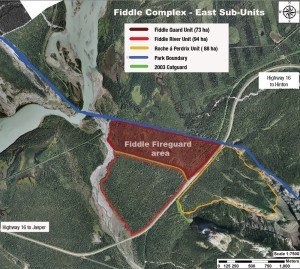 What’s on your mind this winter season? Planning for epic pow days? Hitting the flat-packed trails on your fat bike? Reaching your perfect stride on your cross-country skis? Well, there is only one thing on the minds of Jasper National Park’s fire and vegetation team, and that is restoring the natural process of fire this winter.
What’s on your mind this winter season? Planning for epic pow days? Hitting the flat-packed trails on your fat bike? Reaching your perfect stride on your cross-country skis? Well, there is only one thing on the minds of Jasper National Park’s fire and vegetation team, and that is restoring the natural process of fire this winter.
Winter is the perfect time to carry out important preliminary work for the Fiddle Complex prescribed fire. The Fiddle Complex area is approximately 300 hectares, a little larger than the Town of Jasper, and consists of four sub-units that span the Athabasca Valley along the park’s east boundary.
The fire team has begun work within a down-wind sub-unit which serves as fireguards to help contain subsequent, larger prescribed fires in the complex. With this winter’s snow cover, the crew has been building and strengthening the 73-hectare Fiddle Fireguard sub-unit along the park boundary between Highway 16 and the Athabasca River.
The crew has also been using a portable fire torch—an all terrain vehicle assisted with an ignition device called a Terra Torch—to burn pockets of coniferous (evergreen) trees within the sub-unit. The snow covered ground will contain the ground fire and any burning embers produced to prevent fire spread. This is a cost-effective method to remove the trees during winter, which will help to ensure that subsequent prescribed fire (spring 2016 at the earliest) in this sub-unit will be less complex. Passing motorists and local residents are unlikely to notice the burning as this method produces very little smoke.
This winter’s work augments previous cutting and burning of trees along the park boundary on the south side of Highway 16, on the slopes of Roche à Perdrix.
What are the benefits of the Fiddle Complex Prescribed Fire?
Restoring fire to this area is part of a strategy to protect the Yellowhead corridor from wildfires originating in Jasper National Park, address Mountain Pine Beetle and restore the health of the landscape. Once completed, the complex will provide a valley-wide fireguard.
At the same time, the team is removing Mountain Pine Beetle habitat to help stop or slow downwind, eastward spread. The vigorous regenerated growth after the fires will be better able to withstand future insects and disease.
Finally, this work will allow fire managers to help restore fire and its many ecological benefits in the lower Athabasca Valley, a region with a historically short fire cycle.
Want to know more?
Come out to Jasper in January’s ATCO Street Festival on Saturday, Jan. 24 to roast a marshmallow with Jasper National Park’s fire and vegetation staff and get answers to all your burning questions.
To receive bi-annual Fire and Vegetation Management newsletters, with information on prescribed fires and wildfires, contact Kim Weir, fire communications specialist at [email protected].
Parks Canada
Special to the Fitzhugh
